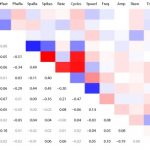Today, I want to introduce a relatively short, but interesting and suggestive paper.
Fast-Forward Playback of Recent Memory Sequences in Prefrontal Cortex During Sleep
Euston DR, Tatsuno M, McNaughton BL.
This paper shows that mPFC neuronal activity was replayed during sleep following task period, and this replay was task dependent. In addition, it is temporally compressed. The authors confirmed these results using two different methods; cross-correlation and template matching. Both analysis shows the pattern is compressed by a factor about 6. It is convincing that similar values are acquired with two distinct ways.
But they don’t mention to correlation between the replay and sleep stages (slow-wave sleep / REM sleep). I wonder whether frequency of mPFC replay were depend on sleep stage. Regarding to this, I’m also interested in whether it is correlated with EEG patterns, especially sharp-waves.
The authors suggest that processing speed of brain is faster than physical limitation. This is unique and interesting view points. But what does the replay do? The replay seems in hundred millisecond order, so it may be too slow to induce synaptic plasticity.




 Diba K, G Buzsáki (2007) Forward and reverse hippocampal place cell sequences during ripples. Nat Neurosci. 10, 1241-1242.
Diba K, G Buzsáki (2007) Forward and reverse hippocampal place cell sequences during ripples. Nat Neurosci. 10, 1241-1242.  Diba K, C Koch, I Segev (2006) Spike propagation in dendrites with stochastic ion channels. J Comput Neurosci. 20:77-84.
Diba K, C Koch, I Segev (2006) Spike propagation in dendrites with stochastic ion channels. J Comput Neurosci. 20:77-84.